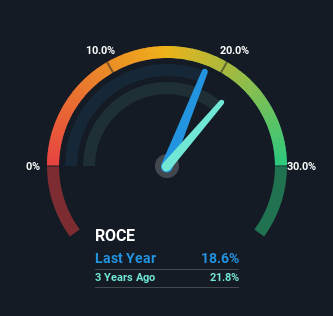Capital Allocation Trends At Happiest Minds Technologies (NSE:HAPPSTMNDS) Aren't Ideal
There are a few key trends to look for if we want to identify the next multi-bagger. One common approach is to try and find a company with returns on capital employed (ROCE) that are increasing, in conjunction with a growing amount of capital employed. If you see this, it typically means it's a company with a great business model and plenty of profitable reinvestment opportunities. However, after briefly looking over the numbers, we don't think Happiest Minds Technologies (NSE:HAPPSTMNDS) has the makings of a multi-bagger going forward, but let's have a look at why that may be.
Return On Capital Employed (ROCE): What Is It?
Just to clarify if you're unsure, ROCE is a metric for evaluating how much pre-tax income (in percentage terms) a company earns on the capital invested in its business. Analysts use this formula to calculate it for Happiest Minds Technologies:
Return on Capital Employed = Earnings Before Interest and Tax (EBIT) ÷ (Total Assets - Current Liabilities)
0.19 = ₹3.0b ÷ (₹22b - ₹5.8b) (Based on the trailing twelve months to September 2023).
Therefore, Happiest Minds Technologies has an ROCE of 19%. On its own, that's a standard return, however it's much better than the 15% generated by the IT industry.
Check out our latest analysis for Happiest Minds Technologies

In the above chart we have measured Happiest Minds Technologies' prior ROCE against its prior performance, but the future is arguably more important. If you're interested, you can view the analysts predictions in our free report on analyst forecasts for the company.
The Trend Of ROCE
The trend of ROCE doesn't look fantastic because it's fallen from 42% four years ago, while the business's capital employed increased by 1,065%. However, some of the increase in capital employed could be attributed to the recent capital raising that's been completed prior to their latest reporting period, so keep that in mind when looking at the ROCE decrease. Happiest Minds Technologies probably hasn't received a full year of earnings yet from the new funds it raised, so these figures should be taken with a grain of salt. Additionally, we found that Happiest Minds Technologies' most recent EBIT figure is around the same as the prior year, so we'd attribute the drop in ROCE mostly to the capital raise.
On a related note, Happiest Minds Technologies has decreased its current liabilities to 26% of total assets. So we could link some of this to the decrease in ROCE. Effectively this means their suppliers or short-term creditors are funding less of the business, which reduces some elements of risk. Some would claim this reduces the business' efficiency at generating ROCE since it is now funding more of the operations with its own money.
Our Take On Happiest Minds Technologies' ROCE
In summary, despite lower returns in the short term, we're encouraged to see that Happiest Minds Technologies is reinvesting for growth and has higher sales as a result. And the stock has done incredibly well with a 154% return over the last three years, so long term investors are no doubt ecstatic with that result. So should these growth trends continue, we'd be optimistic on the stock going forward.
One more thing to note, we've identified 2 warning signs with Happiest Minds Technologies and understanding them should be part of your investment process.
While Happiest Minds Technologies may not currently earn the highest returns, we've compiled a list of companies that currently earn more than 25% return on equity. Check out this free list here.
Valuation is complex, but we're here to simplify it.
Discover if Happiest Minds Technologies might be undervalued or overvalued with our detailed analysis, featuring fair value estimates, potential risks, dividends, insider trades, and its financial condition.
Access Free AnalysisHave feedback on this article? Concerned about the content? Get in touch with us directly. Alternatively, email editorial-team (at) simplywallst.com.
This article by Simply Wall St is general in nature. We provide commentary based on historical data and analyst forecasts only using an unbiased methodology and our articles are not intended to be financial advice. It does not constitute a recommendation to buy or sell any stock, and does not take account of your objectives, or your financial situation. We aim to bring you long-term focused analysis driven by fundamental data. Note that our analysis may not factor in the latest price-sensitive company announcements or qualitative material. Simply Wall St has no position in any stocks mentioned.
About NSEI:HAPPSTMNDS
Happiest Minds Technologies
Provides information technology (IT) solutions and services in India, the Americas, Australia, Europe, Asia, the Middle East, and Africa.
Reasonable growth potential with adequate balance sheet.
Similar Companies
Market Insights
Community Narratives



